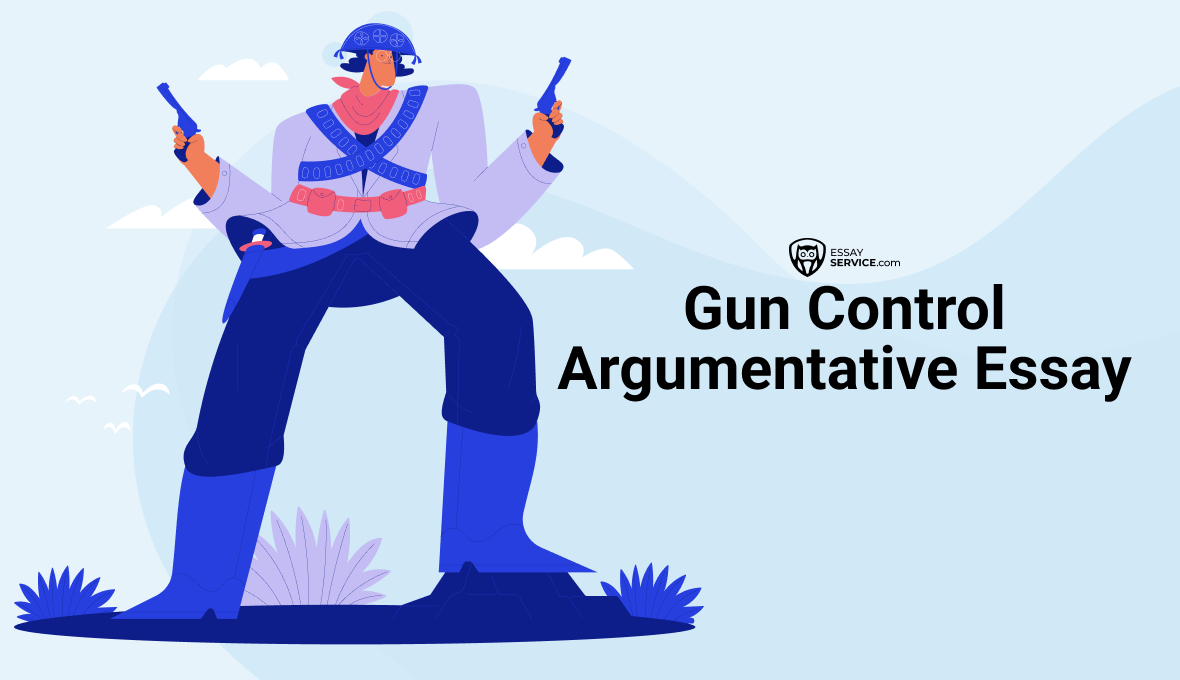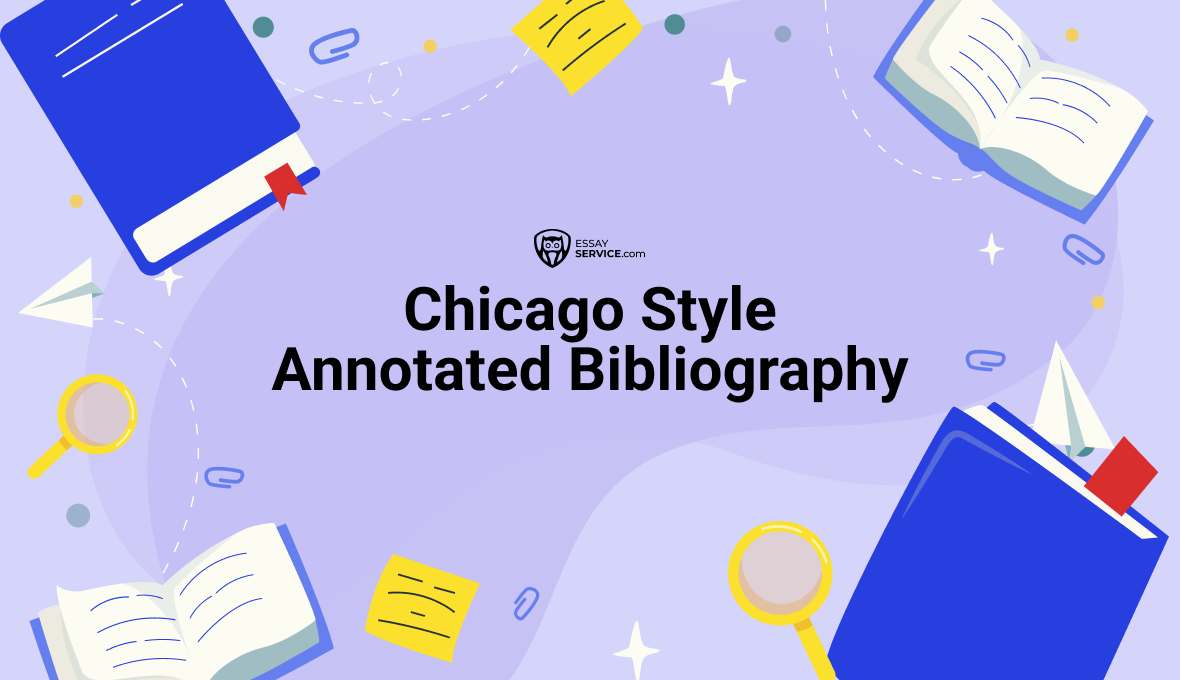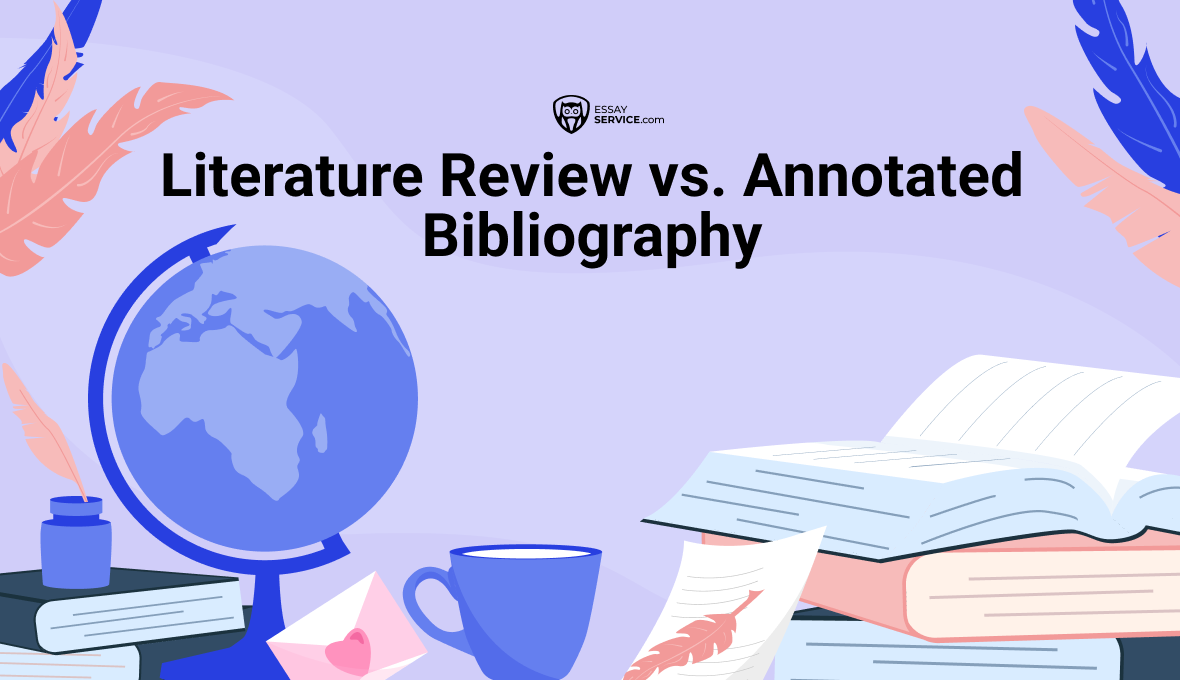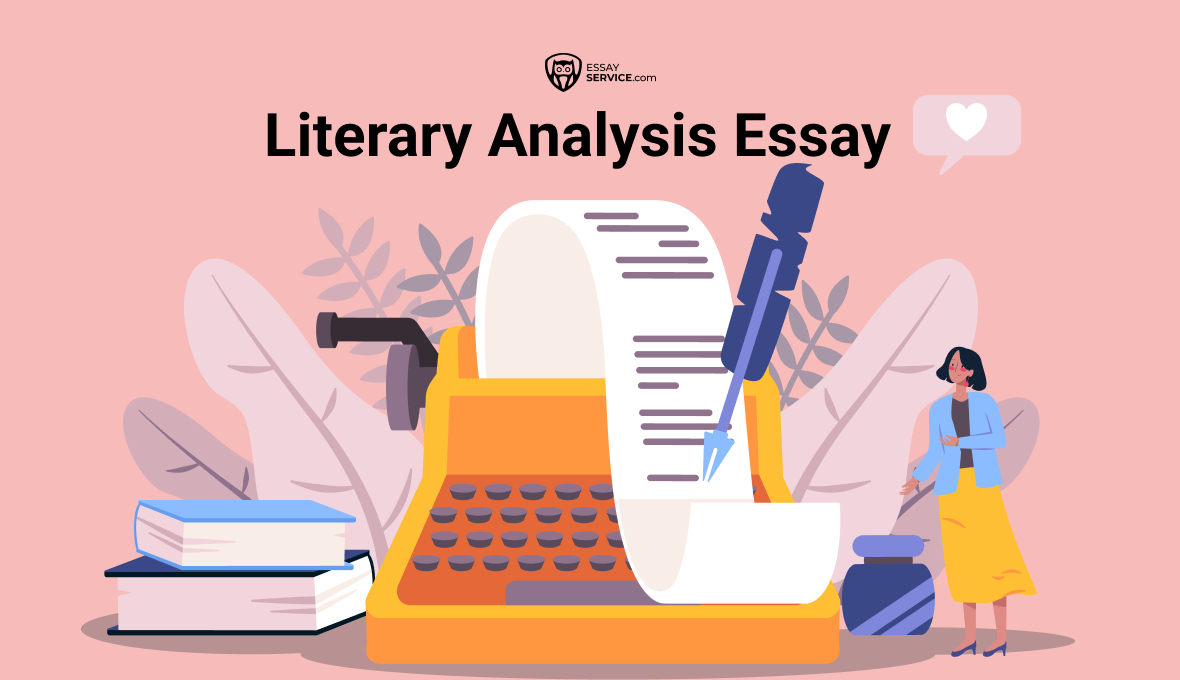
How to Write a Literary Analysis Essay: Definition, Types, Structure, Format, and Examples
A literary analysis essay acts as a compass, helping readers navigate the intricate landscapes of stories, poems, and plays. Think of it as a decoder for the language of books, unraveling the symbols, characters, and structures that make a story tick. These essays aren't just academic exercises – they're like a roadmap, guiding us to uncover the deeper truths and insights tucked away in the narratives we love. When you buy literary analysis essay assistance, get ready to peel back the layers as we unravel the intricacies of literary essays.
What Is a Literary Analysis Essay?
A literary analysis essay definition is a written examination of a literary work, such as a novel, poem, or play, aimed at dissecting its elements to uncover deeper meanings and themes. Unlike a summary or a review, which simply recount the plot or express personal opinions, a literary essay delves into the nuances of the text, scrutinizing its characters, symbols, motifs, and narrative techniques. Through close reading and critical thinking, the essay seeks to elucidate the author's intentions, explore the cultural and historical contexts, and offer interpretations that shed light on the work's significance.
At its core, a literary analysis essay is an exercise in interpretation and argumentation, where the writer presents a thesis or main argument supported by evidence from the text itself. This evidence may include direct quotations, paraphrases, or references to specific scenes or passages that illustrate the writer's analysis. Furthermore, the essay often uses secondary sources, such as literary criticism or scholarly articles, to enrich the discussion and provide additional perspectives. To enrich your knowledge of analysis essay writing, you can also check out our poem analysis essay guide.
Types of Literary Analysis Essay
Literary analysis essays can take various forms, each with unique approaches and objectives. Three common types are argumentative, explanatory, and analytical essays.
Argumentative Literary Analysis Essay
In an argumentative literary analysis essay, the writer formulates a clear and debatable thesis statement regarding the literary work under scrutiny. The essay then seeks to persuade the reader of the validity of this argument by presenting evidence from the text, often in the form of direct quotations or paraphrased passages. The focus is on building a coherent and compelling case to support the interpretation or perspective advanced in the thesis. This type of essay invites discussion and disagreement, encouraging readers to critically assess the writer's stance in light of the evidence presented.
Explanatory
An explanatory literary analysis paper aims to elucidate and clarify specific aspects of a literary work without necessarily advocating a particular argument. The focus here is on providing a comprehensive understanding of the chosen elements, be it characters, themes, or literary devices. Writers of explanatory essays use evidence from the text to illuminate nuances, offering insights and explanations that enhance the reader's appreciation of the work. While not devoid of analysis, the essay’s primary goal is to inform and make the text more accessible rather than to persuade or argue a specific interpretation.
Analytical
The analytical literary analysis essay combines elements of both argumentative and explanatory approaches. It involves a meticulous examination of the text's components, such as characters, symbols, or themes, while also presenting a cohesive essay that contributes to a broader understanding of the work. Analytical essays delve into the "how" and "why" of a literary piece, exploring the author's choices and their impact on the narrative. The focus is on uncovering patterns, exploring motivations, and discerning the significance of various literary elements. While it may not be as explicitly argument-driven as the argumentative essay, an analytical essay still offers a perspective that emerges organically from carefully examining the text. Are you interested to learn more? Explore our guide about a causal analysis essay for more information about academic writing assignments.
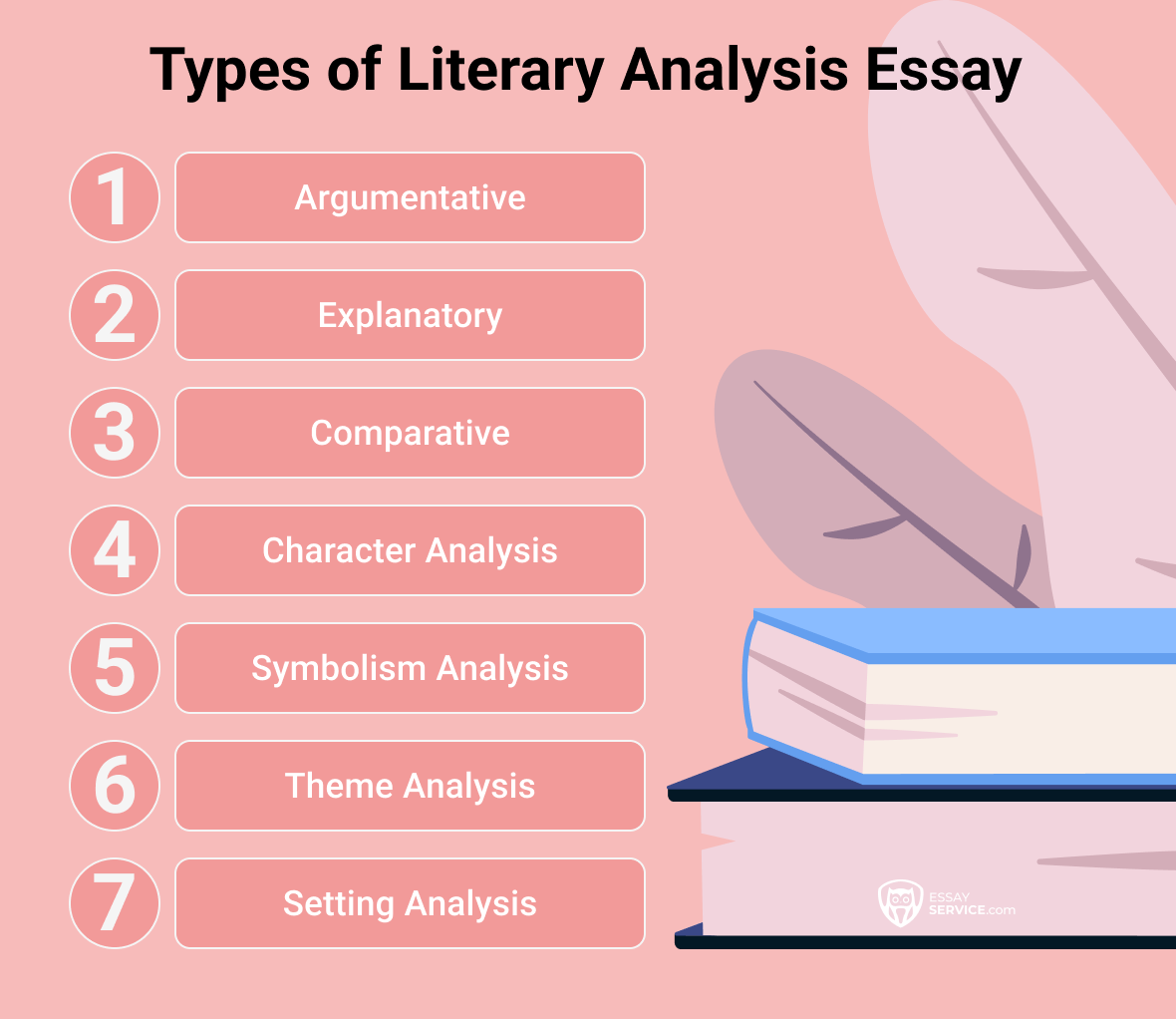
Literary Elements Analysis Essay Writings Should Have
A comprehensive literary analysis essay should encompass various elements to provide a thorough examination of the chosen literary work. By expanding your analysis in these directions, your literary analysis will offer a more nuanced understanding of the complexities inherent in the chosen literary work. This depth allows readers to appreciate the intricate interplay of thematic, structural, and narrative elements within the text. Here are key components to include in your essay:
Theme Literary Analysis Essay
Investigate the evolution of themes throughout the narrative, identifying their subtle variations and exploring how they intersect with one another. Examine the cultural, historical, or philosophical contexts that may influence the author's treatment of these themes in your literary analysis thesis. Consider the potential for ambiguity or multiple interpretations within the thematic elements, adding layers of complexity to the literary work.
Structural Elements
Extend your subject matter to consider the psychological impact of the chosen literary analysis essay structure on readers. Explore how shifts in time or perspective contribute to the narrative's emotional resonance or intellectual engagement. Discuss whether the structural choices serve a thematic purpose, emphasizing certain elements or challenging conventional storytelling norms.
Storyline
Scrutinize the narrative's causality, scrutinizing the cause-and-effect relationships between events in the story. Discuss the significance of pivotal moments and turning points, exploring how they shape the characters and contribute to the overall narrative momentum. Evaluate whether the author uses narrative devices to manipulate the reader's expectations.
Discord
Unpack the complexities of conflicts by considering their broader implications for the characters and the narrative world. Examine how conflicts may serve as allegories or metaphors, representing larger societal issues. Discuss the consequences and resolutions of conflicts, evaluating their impact on character development and the overall thematic resonance.
Protagonists
As stated in our character analysis essay guide, it extends beyond surface traits by considering the characters' roles as symbols or archetypes. Explore the dynamic relationships between characters, investigating how they mirror or subvert societal norms. Discuss any moral or ethical dilemmas characters face and their implications for the overarching themes of the work. Consult our literary character analysis essay example below for more information.
Literary Tropes
Elaborate on the symbolic significance of literary devices, investigating how they contribute to the overall texture of the narrative. Examine the use of allegory or allusion and discuss how these devices enrich the reader's experience, as shown in the literary device analysis essay example below. Explore how the author's choices in employing literary devices align with or challenge literary conventions of the time.
Language Use
Extend the analysis of language choices to consider cultural or historical contexts that may influence the author's linguistic decisions. Discuss the impact of tone shifts and the author's use of regional or specialized language. Evaluate how is the language of the literary analysis essay different from how you speak everyday? Examine how linguistic choices contribute to the creation of atmosphere and the portrayal of characters' perspectives.
Narration Style
Explore the subtleties of narrative voice by considering its reliability or unreliability. Discuss the author's use of point of view as a tool for engaging the reader emotionally or intellectually. Evaluate the narrative voice's role in creating empathy for characters, establishing narrative distance, or fostering a sense of immediacy within the storytelling.
Literary Analysis Essay Outline
The literary analysis essay format typically adheres to the conventional structure of academic essays. It begins with an introduction that provides essential background information, introduces the literary work and author, and presents a clear thesis statement that encapsulates the main argument or interpretation. Following the introduction, the body paragraphs serve as the essay's core, each dedicated to a specific aspect or element of the analysis essay. These paragraphs should begin with topic sentences that convey the main point, followed by supporting evidence from the text and analysis that connects the evidence to the thesis. Transitions between paragraphs ensure a smooth flow of ideas. The conclusion, situated at the essay's end, summarizes the key points, reiterates the thesis, and offers a broader reflection on the literary work's significance. A thoughtful literary analysis essay structure not only showcases analytical prowess but also adheres to the conventions of academic writing.
Literary Analysis Essay Introduction
As you brainstorm a literary analysis essay title, the introduction will serve as a crucial foundation, setting the stage for the entire document. It typically begins with a hook—a compelling statement, question, or quote—to capture the reader's attention and establish the essay's relevance. Following the hook, the introduction provides essential contextual information about the literary work, including details about the author, publication date, and any historical or cultural background that may be pertinent. How do you start a literary analysis essay has to culminate in a thesis statement, which succinctly outlines the main argument or interpretation the essay will explore. This thesis acts as a roadmap, guiding the reader on the analytical journey ahead. A well-crafted introduction not only entices the reader but also provides a clear direction for the subsequent essay analysis.
Main Body
Let’s learn how to write a body paragraph for a literary analysis essay next. It comprises multiple paragraphs, each dedicated to a specific facet of the analysis. These paragraphs should follow a cohesive and logical structure. Typically, each paragraph begins with a topic sentence that introduces the main point of the paragraph, followed by evidence from the literary work—direct quotations, paraphrased passages, or examples. After presenting the evidence, the writer engages in thorough analysis, connecting the essay’s evidence back to the thesis statement. This process is repeated for each distinct element or aspect being analyzed, with the body paragraphs contributing to the overall argument. Effective transitions between paragraphs ensure a smooth flow of ideas, guiding the reader through the nuanced exploration of the literary work.
Concluding Paragraph
The conclusion of a literary analysis serves to synthesize the key points and provide a sense of closure. It begins by summarizing the main arguments and findings presented in the body paragraphs, reminding the reader of the critical aspects explored. However, a conclusion goes beyond mere repetition; it offers a broader reflection on the significance of the essay’s analysis. This could involve connecting the literary work to broader themes, drawing implications for the reader, or suggesting avenues for further exploration. The conclusion should reinforce the thesis statement, leaving a lasting impression on the reader and emphasizing the enduring impact and relevance of the analyzed literary work. A well-crafted conclusion ensures that the reader departs with a comprehensive understanding and appreciation of the nuanced interpretations provided in the essay. Below, you will find a literary analysis essay conclusion example offering a practical understanding of this subject.
What Are the Best First Steps When Writing a Literary Analysis Essay?
When initiating a literary analysis essay, it's essential to establish a strong foundation. By expanding your approach to include these additional considerations, your literary analysis piece will not only delve into the surface-level aspects of the text. Still, it will also provide a more comprehensive exploration of the work's nuances, context, and potential impact on readers. Here are five key first steps regarding how to write a literary analysis essay:
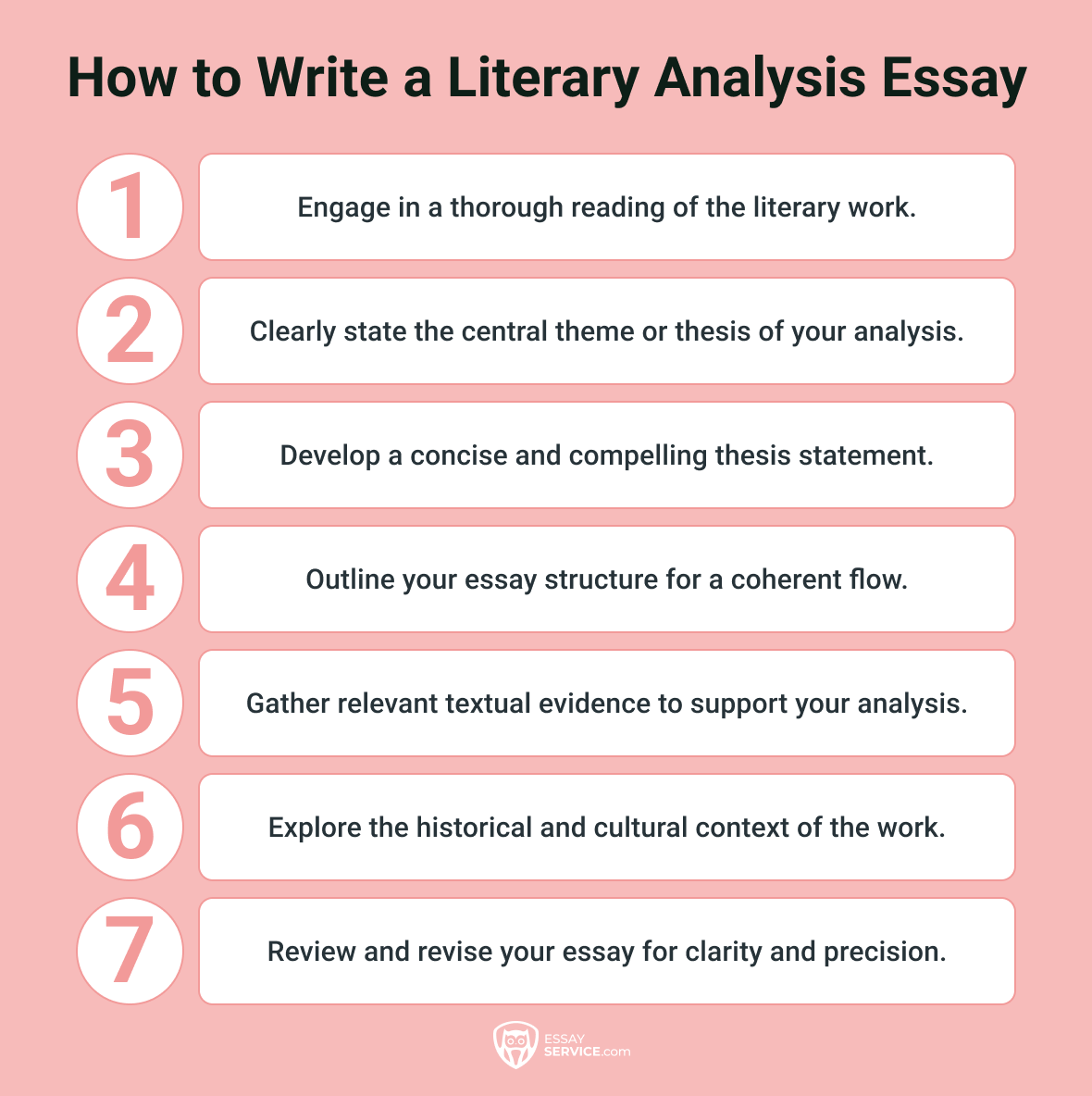
Contextualize the Source Material
Explore the historical, cultural, and societal context in which the literary work was written. Consider the author's background, the time period, and any relevant events that might have influenced the creation of the text. Understanding the broader context of a text analysis essay provides valuable insights into the motivations behind the author's choices and enhances the depth of your analysis. To find out more, please consult our critical analysis essay writing guide.
Examine Critical Perspectives
Before finalizing your analysis essay, survey existing literary criticism and interpretations of the work. Familiarize yourself with different perspectives and scholarly discussions related to the text. This step not only enriches your understanding but also allows you to position your analysis essay within the broader academic discourse, showcasing a nuanced engagement with the text. To understand this topic better, explore our example of literary analysis essay below.
Analyze Character Development and Relationships
Delve into the intricacies of character development and relationships that have to be listed in your literary analysis essay outline. Consider how characters evolve, the motivations driving their actions, and the dynamics between them. Analyzing characters beyond surface traits contributes to a more profound exploration of the author's intentions and the thematic elements embedded in the narrative.
Evaluate Symbolism and Literary Devices
When writing a literary analysis paper, pay special attention to the symbolism and literary devices the author employs. Uncover the deeper meanings behind symbols, metaphors, allegories, or any stylistic choices. Discuss how these elements contribute to the overall texture of the narrative, reinforcing themes or adding layers of meaning that may not be immediately apparent.
Consider Reader Response
Reflect on how your essay might resonate with potential readers. Anticipate possible reactions and interpretations to your book analysis essay, acknowledging that literary works often invite diverse perspectives. Consider how your insights contribute to the ongoing conversation about the text and how readers might engage with or challenge your interpretations, which can be studied in our rhetorical analysis essay guide.

Literary Analysis Examples
Consulting an example of a literary analysis essay provides students with a tangible model, offering a practical illustration of how to structure and approach their own writing. It serves as a valuable learning tool by showcasing effective techniques for analyzing literature, constructing arguments, and incorporating evidence from the text. Additionally, exposure to well-executed examples helps students grasp the nuances of a critical essay, enhancing their ability to convey insights and interpretations in their own essays.
Literary Analysis Essay Example #1
The Transformation of Ebenezer Scrooge in Charles Dickens's "A Christmas Carol"
Ebenezer Scrooge, the central character in Charles Dickens's novella "A Christmas Carol," undergoes a profound transformation that serves as the heart of the narrative. At the outset, Scrooge is introduced as a miserly and callous old man, characterized by his relentless pursuit of wealth and disdain for the holiday spirit. However, through a series of supernatural encounters with the Ghosts of Christmas Past, Present, and Yet to Come, Scrooge experiences a powerful metamorphosis, evolving from a symbol of greed to a beacon of generosity and compassion.
In the opening scenes, Dickens paints Scrooge as a solitary figure, isolated by his obsession with money and indifferent to the suffering of others. The author employs vivid descriptions of Scrooge's frugal habits and curt interactions to establish his cold and unyielding demeanor. This sets the stage for the transformative journey that unfolds as the narrative progresses.
The Ghost of Christmas Past catalyzes Scrooge's evolution, taking him on a nostalgic expedition through his own life. As the audience witnesses Scrooge's younger self and glimpses into the moments that shaped his worldview, a deeper understanding of his guarded nature emerges. The portrayal of Scrooge's lost love, Belle, and the dissolution of their engagement unveils the emotional wounds that contribute to his present state of bitterness.
The Ghost of Christmas Present further exposes Scrooge to the lives of those around him, revealing the joy and camaraderie he has denied himself. The contrasting scenes of warmth and festivity in the Cratchit household highlight Scrooge's own emotional impoverishment. The character's transformation begins as he becomes increasingly empathetic to the struggles of the Cratchit family, particularly Tiny Tim's vulnerability, which serves as a poignant reminder of the consequences of his own choices.
The culmination of Scrooge's redemption occurs during the harrowing visit from the Ghost of Christmas Yet to Come. Confronted with his own mortality and the bleak future that awaits if he does not change, Scrooge is propelled into a moment of profound self-reflection. The symbolism of his own gravestone becomes a powerful metaphor for the legacy he is currently constructing.
In the final scenes, Dickens masterfully portrays Scrooge's newfound benevolence. The character's spontaneous generosity towards the Cratchits and his embrace of the holiday spirit radically departs from his earlier persona. Scrooge's transformation symbolizes the capacity for human redemption, illustrating Dickens's timeless message about the transformative power of empathy and generosity.
In conclusion, Charles Dickens uses Ebenezer Scrooge as a vehicle for exploring the potential for change and redemption within the human spirit. Through the character's encounters with the supernatural, Dickens crafts a narrative that emphasizes the importance of compassion, self-reflection, and the pursuit of a more meaningful existence. Scrooge's journey from a miserly recluse to a symbol of benevolence serves as a timeless reminder of the enduring power of personal transformation.
Literary Analysis Essay Example #2
Symbolism in William Golding's "Lord of the Flies"
William Golding's novel "Lord of the Flies" is a rich tapestry of literary devices, with symbolism standing out as a powerful element that shapes the narrative. Throughout the story, various symbols serve as potent metaphors, shedding light on the innate human capacity for savagery and the fragility of societal order. Golding masterfully employs symbols such as the conch shell, the beast, and the signal fire to convey profound insights into the darker aspects of human nature.
One of the most prominent symbols in the novel is the conch shell, which initially serves as a tool for order and democracy. When the boys first discover the conch, it becomes a unifying force, representing establishing rules and the desire for civilization. However, as the story unfolds, the conch's significance deteriorates, paralleling the disintegration of societal order on the island. The eventual shattering of the conch during a chaotic assembly symbolizes the complete collapse of the boys' attempts to maintain a civilized society, highlighting the fragility of human-created structures in the face of primal instincts.
The recurring image of the "beast" serves as another compelling symbol, embodying the primal, instinctual nature within each individual. Initially perceived as an external threat, the realization that the true beast resides within the boys becomes a central theme. Golding uses the beast as a metaphor for the darkness within the human psyche, exploring how fear and desperation can unleash destructive tendencies. The shifting nature of the beast—from a perceived external force to an internal, inherent aspect of humanity—serves as a chilling commentary on the potential for moral decay when societal constraints are removed.
The signal fire, initially lit as a means of rescue, undergoes a transformation that mirrors the descent into savagery. At first, the fire symbolizes hope and the boys' connection to the outside world. However, as the boys succumb to their primal instincts, the fire becomes a tool for destruction, leading to unintended consequences. The burning of the island's entire landscape underscores the destructive power that lies within the boys and the consequences of losing touch with the values of civilization.
In conclusion, William Golding's skillful use of symbolism in "Lord of the Flies" adds depth and layers of meaning to the narrative. Golding crafts a nuanced exploration of human nature and societal dynamics through the conch shell, the beast, and the signal fire. The symbols serve as vehicles for profound commentary on the fragility of civilization, the inherent darkness within individuals, and the consequences of abandoning societal norms. Golding's use of symbolism elevates "Lord of the Flies" beyond a mere adventure story, transforming it into a thought-provoking exploration of the complexities of human behavior.
Summing Up
Knowing how to write a literary essay is crucial for students as it cultivates essential skills that extend beyond the realm of literature. Firstly, literary essays foster critical thinking by requiring students to analyze and interpret complex texts. This skill is transferable to various academic disciplines and real-world situations, enabling individuals to approach challenges with a nuanced and analytical mindset. Additionally, literary essays enhance communication skills, honing students' ability to articulate ideas coherently and persuasively. This proficiency is invaluable in academic and professional settings where effective communication is paramount.
Frequently asked questions
How to Write a Literary Analysis on the Same Day?
Writing a literary analysis essay on the same day requires a focused and efficient approach. Start by selecting specific literary elements analysis essay writings are meant to analyze, whether it's a theme, character, or literary device. Quickly outline your main points and thesis, ensuring a clear direction for your analysis essay. Prioritize evidence supporting your argument, and be concise in your essay. Utilize quotations judiciously to bolster your points. Streamline your essay structure with a clear introduction, body paragraphs, and a succinct conclusion. While time constraints are challenging, focusing on key elements and avoiding unnecessary details will enable you to produce a concise and effective literary analysis within a tight timeframe.
What Is an Example of Literary Analysis Essay?
A literary analysis essay example college students can refer to is found in examining the character Ebenezer Scrooge in Charles Dickens's "A Christmas Carol." This essay analysis delves into Scrooge's transformation from a miserly and callous individual to a compassionate and generous one. By exploring the character's evolution, the essay will discuss key moments, such as encounters with the Ghosts of Christmas Past, Present, and Yet to Come, and how these events contribute to Scrooge's redemption. The analysis essay will also delve into Dickens's use of symbolism and character development to convey broader themes about human nature and the spirit of Christmas, providing a comprehensive exploration of the literary work.
What Are the Best First Steps When Writing a Literary Analysis Essay?
The best first steps when writing a literary analysis essay involve a systematic approach. Begin by thoroughly reading and understanding the text, identifying central themes, characters, and elements. Formulate a clear thesis statement encapsulating your main argument, providing a roadmap for your analysis essay. Organize your thoughts by outlining the structure of your essay, ensuring a logical flow and coherence. Gather supporting evidence from the text, focusing on relevant quotes and examples. Lastly, consider the broader context, such as the author's background and critical perspectives, to enrich your exploration. These steps lay a solid foundation for a thoughtful and insightful literary analysis composition.
New posts to your inbox!
Your submission has been received!

